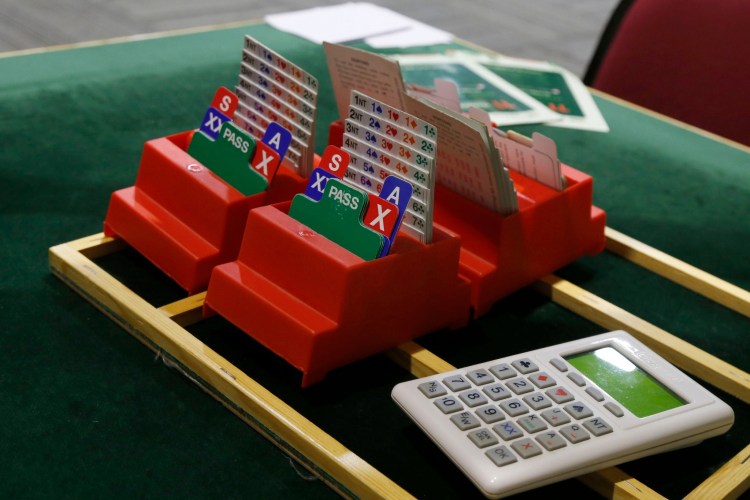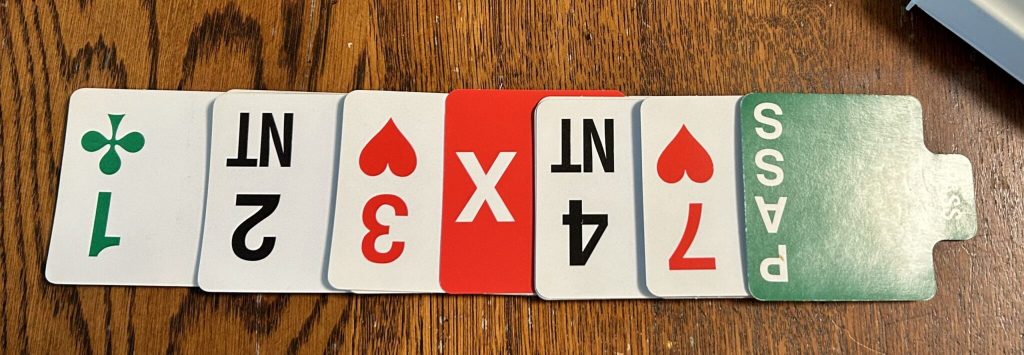A Bidding Box contains cards representing the different bids from 1♣ all the way up to 7Nt, and calls such as pass, double, redouble, and alert. Players use these cards instead of bidding out loud.
What Are Bidding Boxes in Bridge, and How Do I Use One?

What Are Bidding Boxes in Bridge, and How Do I Use One?
by Jude Goodwin © Great Bridge Links
In its simplest form, bridge is a whist-like card game played with a single deck of 52 playing cards (no jokers) and four people who make up two partnerships. It is played in three basic stages:
- The bidding
- The play of the cards
- The scoring
In this article, part of a series called Bridge Basics, we will talk about the bidding box, a device used in duplicate bridge during the bidding stage.
A Bidding Box contains cards representing the different bids from 1♣ all the way up to 7Nt, and calls such as pass, double, redouble, and alert. Players use these cards instead of bidding out loud. Bidding boxes are most common in duplicate bridge tournaments, where they help maintain a quiet environment and prevent unintended signals. But these boxes have become essential equipment, even for home games.
When I used to play bridge with my parents 35 years ago, they had their own set of bidding boxes that they would bring out for home games even though they had never played duplicate. It might feel a bit awkward at first, using the bidding cards instead of speaking your bid out loud, but you’ll quickly get used to it and will appreciate how they make the game more pleasant for so many reasons.
For one thing, you will never miss a bid again – because all the bids remain face up on the table until you agree that you’ve seen them all. Having to ‘review the bidding’ will be a thing of the past. This is very helpful for new players especially as a teacher can pause the game when the bidding is done and invite questions about the bidding. And it’s actually quite legal to do this in a game at any level – pause and ask questions about the bids, before moving on to the play of the hand
For another thing, players won’t be able to influence the game using voice inflection. We’ve all played bridge with that uncle who will say “pass?” like a question or “Pass!!!” loudly in order to be sure your aunt knows she’s not to bid again. With bidding boxes players will be less likely to convey unauthorized information with their tone of voice.
Let’s take a look at bidding boxes, their history and the basics on how to use them.
History of Bidding Boxes
The bidding box was invented in 1962 by Swedish bridge enthusiast Gösta Nordenson. Its first use in a major tournament was in 1970 during the World Bridge Championships in Stockholm. The invention attracted the attention of Eric Jannersten, a well-known bridge player and founder of Jannersten Förlag AB, who popularized the bidding box in European tournaments.
Bidding boxes quickly gained popularity in Europe and eventually spread to bridge clubs in the United States. Today, they are widely used in bridge tournaments around the world and have become a staple in many casual games due to their practicality and added structure.
An interesting tidbit – the term “Bidding Boxes” was registered as a trademark by Jannersten Förlag AB on July 9, 1985, under U.S. Registration Number 1348196. This registration covered “bid indicators used in the card game of bridge.” Due to this trademark, some bridge organizations and publications adopted alternative terms like “bid boxes” to avoid potential trademark infringement. This practice allowed them to refer to the devices without using the trademarked term. Over time however, the term “bidding boxes” has become commonly used across most bridge organizations and publications.

Structure and Components
- A standard bidding box is a plastic device with two main slots, each containing specific cards. One slot holds bidding cards for various bids across suits (clubs, diamonds, hearts, spades, and no-trump) and bidding levels (1 through 7). The other slot has calling cards for pass, double, and redouble, as well as optional cards like alert and stop.
- Bidding boxes come in free-standing forms, usually placed in the table corners, or in smaller, clamp-on varieties. For left-handed players, specialized boxes are available where the cards are organized in a mirrored layout to accommodate a left-handed hold.
- Cards in the bidding slot are arranged like a rolodex, with each card staggered for easy selection, and bid cards often have a results chart on the back for reference.
- There are a few different styles, including one that hangs from the table. You can see a variety on Eric Jannersten’s bridge shop here.
How to Use a Bidding Box: Step-by-Step Guide
Setting Up the Box:
- Arrange the bidding cards (suit bids and no-trump bids) in one slot, with each level ordered from lowest to highest. Place calling cards (pass, double, redouble) in the other slot, and add the alert and stop cards if included.
- Position the box at the right-hand side of each player at the table (four boxes per table), ensuring that each player can access their own box without crowding. If you’re left handed, there are left handed boxes available. Some bridge clubs have tables with slide-outs for the boxes. Some use hanging boxes.

Making a Call or Bid (see image above):
- To make a bid, select the appropriate card by placing your thumb on it and pulling out the entire stack of lower-ranking cards beneath it. For example, when bidding 1♥, you’ll remove 1♣ and 1♦ along with 1♥ and place it in front of you with the desired bid (1♥) on top. Ensure your bid faces outward for the other players to see. Lower bids will be a slim stack, while slam bids will be thick.
- As you make each new bid, you place it to the right of the previous bid, so the bids are laid out in a horizontal row.
- For a pass, double, or redouble, place the card as though it were a bid in the same row as the bids.
- When placing a bid or call don’t cover the previous, put it to the right slightly.
- See the image above for a sample auction. This is how the bids would look in front of you. Notice how they face the opponents, and how the Double is inserted into the auction in the same way it would be if you were speaking out loud.
Special Cards:
- The Alert card signals opponents that the partner’s bid has a specific, non-standard meaning, which is determined by tournament guidelines. To alert a bid, you simply pull the alert card out of the box and tap the table with it, until you’re sure everyone has seen. Some bidding boxes will have an Alert Strip which sticks up from the side. With these you will tap the strip rather than show a card. “Alerting” rules vary by tournament and may be set by the governing body of the event, such as the ACBL. Here’s a link to the ACBL’s most recent Alerts Procedure update – but if you’re just starting out, you might not need to worry about Alerts for now.
- The Stop card used to be used before a jump bid. Although the ACBL discontinued the stop card, it is still in use in some tournaments around the world. When using it, display the stop card briefly, make the bid, and then remove it. The next player should wait about 10 seconds before making a call. Before the advent of Bidding Boxes we used to say “I’m going to make a skip bid, please wait 10 seconds.” and then after our bid, the left hand opponent would have to wait before they bid. This was to help maintain an even rhythm to the auction. Whether or not the stop card is used, it’s still good form to wait 10 seconds before bidding after a skip bid.
Ending the Auction:
- The auction ends once three consecutive players pass and have played a green pass card on their bidding row. Before anything else, it’s good form to wait to be sure everyone has had time to review the auction. Then, each player returns their pass, double, and redouble cards to the box, followed by the bid cards, returning the box to its original setup for the next deal.
Why do we use Bidding Boxes?
We’ve touched on this above, but here’s a good list of advantages to using the device:
- Reduced noise: Essential in large tournaments where multiple tables are active.
- Privacy of bids: Bidding boxes ensure you won’t hear bids from other tables, nor inadvertently overhear an auction when walking by.
- Increased clarity: By using cards, bidding miscommunications are minimized, benefiting players with hearing impairments.
- Reviewable auction: Since bids remain on the table, players can review them as needed.
- Prevention of unauthorized information: Using cards eliminates nuances in speech that could unintentionally convey information.
Frequently Asked Questions (FAQ)
1. What should I do if I make a mistake while bidding?
If you accidentally pull out the wrong card, you can correct it without penalty, provided you do so immediately, without hesitation, and before your left hand opponent has made their call. In tournament play, you may need to call the director for any adjustment.
2. Are bidding boxes mandatory in bridge tournaments?
Yes, in many duplicate bridge tournaments, especially in ACBL-sanctioned events. Players in these settings are expected to use them, though exceptions are sometimes made for new players or those with specific needs.
3. What are the accessibility options for bidding boxes?
Bidding boxes for left-handed players are available. Additionally, players with hearing impairments benefit significantly from using them, while those with physical limitations may be exempted upon request.
4. How does the Stop card work, and why was it discontinued by ACBL?
The Stop card was intended to give the next player a few seconds to consider their bid, avoiding tempo-related clues. ACBL removed it in 2018, finding that players could maintain a steady bidding rhythm without it.
5. Can I use my own left-handed bidding box in a tournament?
Most tournaments allow left-handed players to bring and use their own boxes if they prefer.
6. Where can I purchase Bidding boxes for my home games?
Bidding boxes can be found in sets of four at any bridge supply shop, as well as on Amazon. A set of four can be had for under $25 usd. Once you have the boxes, don’t worry if you spill beverages or food on the cards. Replacement cards can also be easily purchased. You’ll find a good geographic list of bridge shops on Gifts & Supplies for Card Players to help you shop in your part of the world.
The Final Bid
Bidding boxes have streamlined and standardized the auction process in bridge, reducing miscommunication and enhancing game fairness. By providing a quiet and organized way to bid, they allow players to focus on strategy without distraction. With this guide, players of all experience levels can confidently incorporate bidding boxes into their game, enjoying bridge with all the advantages this essential tool provides.
About the author:
Jude Goodwin is a Life Master, bridge blogger and cartoonist living in Vancouver, BC. Jude has been playing bridge since the early 1970s, was editor and publisher of the Canadian Bridge Federation‘s magazine Bridge Canada for over 35 years (now retired), is the author of the bridge book, Teach Me To Play, and two books of bridge cartoons. Jude is the publishing editor and owner of Great Bridge Links, launched in 1995 and Gifts & Supplies for Card Players.








